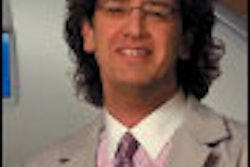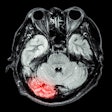It's no secret that the U.S. is struggling to cope with a rising tide of obesity as sedentary lifestyles and poor eating habits prompt Americans to pack on the pounds. Obesity's cost to the healthcare system is well known, as heavier patients experience a wide range of medical conditions, from diabetes to heart problems.
But obesity's impact on radiology is just beginning to get the attention it deserves. Once a rare occurrence, imaging facilities are finding that an increasing number of patients simply do not fit on imaging equipment designed for "average-sized" patients, or that conventional imaging parameters are not sufficient to penetrate extra layers of patient fat.
That's a conundrum, because obese patients with their associated comorbidities frequently require more imaging studies. The rising popularity of bariatric surgery -- which frequently uses imaging to confirm the placement of gastric bands -- is also leading to an influx of obese patients into imaging suites.
Fortunately, imaging vendors are beginning to adjust with equipment modifications that include higher table weights, wider scanner bores, and other features that make scanning obese patients more practical. Imaging facilities are also developing new tactics and imaging parameters for handling the new supersized generation of patients.
A special set of challenges
Statistics underline the obesity epidemic. At Massachusetts General Hospital (MGH) in Boston, the number of obese patients being admitted nearly doubled in 10 years, going from 9% of admissions in 1991 to 16% in 2001, according to MGH radiologist Dr. Raul Uppot.

"The minute you start hitting 250 lb, you start to see difficulties in imaging."
-- Dr. Raul Uppot, Massachusetts General Hospital, Boston
Two main issues arise with imaging obese patients, the first being the attenuation properties of human tissue, which typically begins to become a factor in patients weighing 250 lb and over. "The minute you start hitting 250 lb, you start to see difficulties in imaging," Uppot said. This is particularly true for projection x-ray and ultrasound, he said.
Problem two is the sheer difficulty of handling large patients, many of whom aren't able to move themselves. Five documented employee injuries resulted when one 500-lb man spent several weeks at a Kaiser Permanente Hospital in Fresno, CA, in 2000. Patients sometimes don't fit into scanner bores, or may be too heavy to be supported by patient tables that can't handle the strain.
What happens when a patient doesn't fit on conventional imaging equipment? In one case at MGH, a patient with abdominal pain suspicious for appendicitis wouldn't fit on the hospital's CT machine, so the person was just observed for several days, then sent home. In the most extreme cases, patients who can't be imaged undergo exploratory surgery instead, a practice all but abandoned since the introduction of CT.
In bariatric imaging, the modality of choice is usually fluoroscopy due to its ability to visualize contrast flow in real-time. Fluoroscopy is used to confirm the placement of laparoscopic gastric bands, in post-op barium studies, and to monitor post-op complications. It's also used in preoperative placement of vena cava filters and in transjugular intrahepatic portosystemic shunt (TIPS) procedures. TIPS placements help diabetics control glycemic levels with a stent placed in the middle of the liver to reroute blood flow.
But these procedures in many cases require special handling. In Uppot's latest research, published in the February 2007 issue of the American Journal of Roentgenology, he wrote: "Obese patients may also require high doses of weight-based sedative medications, which may put them at risk for respiratory depression.... If patients do not tolerate the administered doses of sedatives, the use of a mix of different active sedatives" may be necessary. If a patient isn't a good candidate for conscious sedation, general anesthesia may be mandatory (American Journal of Roentgenology, February 2007, Vol. 188, No. 2, pp. 433-440).
Fortunately, healthcare providers and vendors alike are scrambling to develop techniques and equipment that will penetrate body habitus, support heavier patient weights, and prevent radiation burns from the increased dosages.
Tips for handling obese patients
Aurora Sinai Medical Center in Milwaukee has seen a 20% jump in bariatric procedures from 2005 to 2006. The center has developed a number of work-arounds for patients who exceed the weight limits on its equipment, according to Joylyn Kralik, supervisor of diagnostic radiology.
"When the table can't support the patient's weight for the preoperative screening of bariatric gastric bypass, we'll attempt to do the fluoro and postfilms with the patient standing," Kralik said. "The studies routinely performed are chest x-ray, UGI (upper gastrointestinal imaging), and gallbladder/limited abdominal ultrasound."
Uppot says MGH sometimes uses the standing method in very large patients, with a static chest x-ray to confirm gastric banding placement. But projection radiography is far from ideal because it lacks the ability of fluoroscopy to view anatomy in real-time, he said.
In other modalities, a standard method for improving image quality in obese patients can be stated simply: turn up the power.
"You can improve the image quality," Uppot noted. "For CT, you increase the kVp and mAs, and decrease the gantry rotation speed. For ultrasound, you have to try to position the patient properly and use the lowest-frequency transducer. For MRI, use the machine with the most power. A 3-tesla machine will probably generate a better image than a 1.5-tesla."
Industry responds
With bariatric surgery booming, more radiography vendors have introduced tables and openings that support larger patients.
Uppot noted that some MRI scanners now accept patients weighing up to 550 lb and have a bigger bore, and some CT systems accept up to 680 lb and have a gantry diameter of 90 cm. Some fluoroscopy equipment is even available with weigh limits as high as 700 lb. With 27% of the U.S. population being obese, some manufacturers view this market as an opportunity, Uppot quipped.
In x-ray instrumentation, digital fluoroscopy has an edge over analog radiography/fluoroscopy (R/F) in penetrating body habitus. "There's less motion, and anatomy is well penetrated during live fluoro," Kralik said. Flat-panel detectors also are less bulky than image intensifiers, leaving more room to accommodate larger patients. Uppot recommends using pillows and sandbags to stabilize patients.
The newest generation of x-ray systems offers boosted kVp and mAs needed to penetrate thicker layers of tissue. It helps if your x-ray tube has a high heat capacity, because it may run at high levels for long periods of time.
Aurora Sinai recently acquired one of the new generation of digital pulse fluoro systems. Kralik has found that "the mAs and kVp parameters haven't changed due to the 80-kW generator and the pulse fluoro feature."
"The parameters employed in routine general radiography, however, have increased about 25% to 30% due to our utilization of CR for image processing," she said. "For example, a PA chest view on a patient with an average habitus is imaged at 109 kVp and 16 mAs, compared to an obese patient who is imaged at 109 kVp and 20-plus mAs."
Dr. Daniel Croteau, an interventional radiologist at Henry Ford Hospital in Detroit, is juggling an influx of new patients since the hospital's designation last year as a Bariatric Center of Excellence by the American Society for Bariatric Surgery and Blue Care Network. The hospital has performed more than 1,000 bariatric surgeries since opening in 2002, including open and laparoscopic Roux-en-Y gastric bypass and laparoscopic adjustable gastric banding.
"With things that are more complex than a simple filter insertion, the imaging becomes more difficult to do because of the amount of radiation that's needed to penetrate these patients," Croteau continued. "We have ongoing dose amounts that are set into the machine. On one machine, for example, we have a percent of 2 Gy, and then a dose-area product calculation that's ongoing, so that we know how much dose the patient's receiving over the time of a procedure. Another machine is similar, except it's calculated in mGy. When we start getting high percentages, if we can do oblique imaging, we'll actually move the tube around so that the radiation dose isn't coming in at the same area from the same projection, and that decreases the chance of skin burns. That's a help with radiation protection of the patients and the operators."
Croteau added, "There's no angio suite we're looking at purchasing ever again with a weight limit lower than 440 lb. Occasionally, we'll have to do a filter placement in the operating room because of table limit. We actually brought an OR table down into our angio suite and configured it there for a patient who weighed 500 lb."
Bill Broaddus, director of radiology services at Central Baptist Hospital in Lexington, KY, said, "Historically, UGIs and barium enema studies have been our biggest challenge, because of the need to move the patient on and with the table to acquire all the images involved."
Broaddus said a lot of retakes were required with his bariatric patients until the hospital acquired two new heavy-duty R/F systems with flat-panel detectors. "The weight capacity is 500 lb with table movement, and 600 lb static. The tabletops are larger than the ones on our older units, and the distance between the tabletop and the fluoroscopy tower is wider. If you're buying new fluoroscopy equipment today and not looking at DR flat-plate technology, you need to take a second look."
By Sydney Schuster
AuntMinnie.com contributing writer
March 1, 2007
Copyright © 2007 AuntMinnie.com



















